Saludos cordiales, comunidad de Foodies Bee Hive. Durante la semana pasada celebramos el cumpleaños de mi hija menor, y como obsequio pidió que le prepararan dangos, un tipo de dulce japonés, que probablemente por la televisión o YouTube, se trata de unos pequeños bollos de masa de arroz glutinoso endulzados que se preparan saborizados con té matcha, jarabe de fresa o granadina o simplemente al natural y se suelen servir en forma de brocheta. En nuestro caso debimos ingeniárnosla un poco para prepararlos, pues no disponíamos ni en casa ni en el mercado local de varios de los ingredientes, así que improvisamos un poco, si bien el resultado no fue el que esperábamos mi hija los disfruto mucho y estuvo comiéndolos por varios días después de su cumpleaños.
Warm greetings, Foodies Bee Hive community. Last week we celebrated my youngest daughter's birthday, and as a gift she asked for dangos, a type of Japanese sweet, which probably from TV or YouTube, are small sweetened glutinous rice dumplings that are prepared flavored with matcha tea, strawberry syrup or grenadine or just plain and are usually served in the form of skewers. In our case we had to improvise a little to prepare them, as we did not have many of the ingredients at home or in the local market, so we improvised a little, although the result was not what we expected, my daughter enjoyed them a lot and was eating them for several days after her birthday.
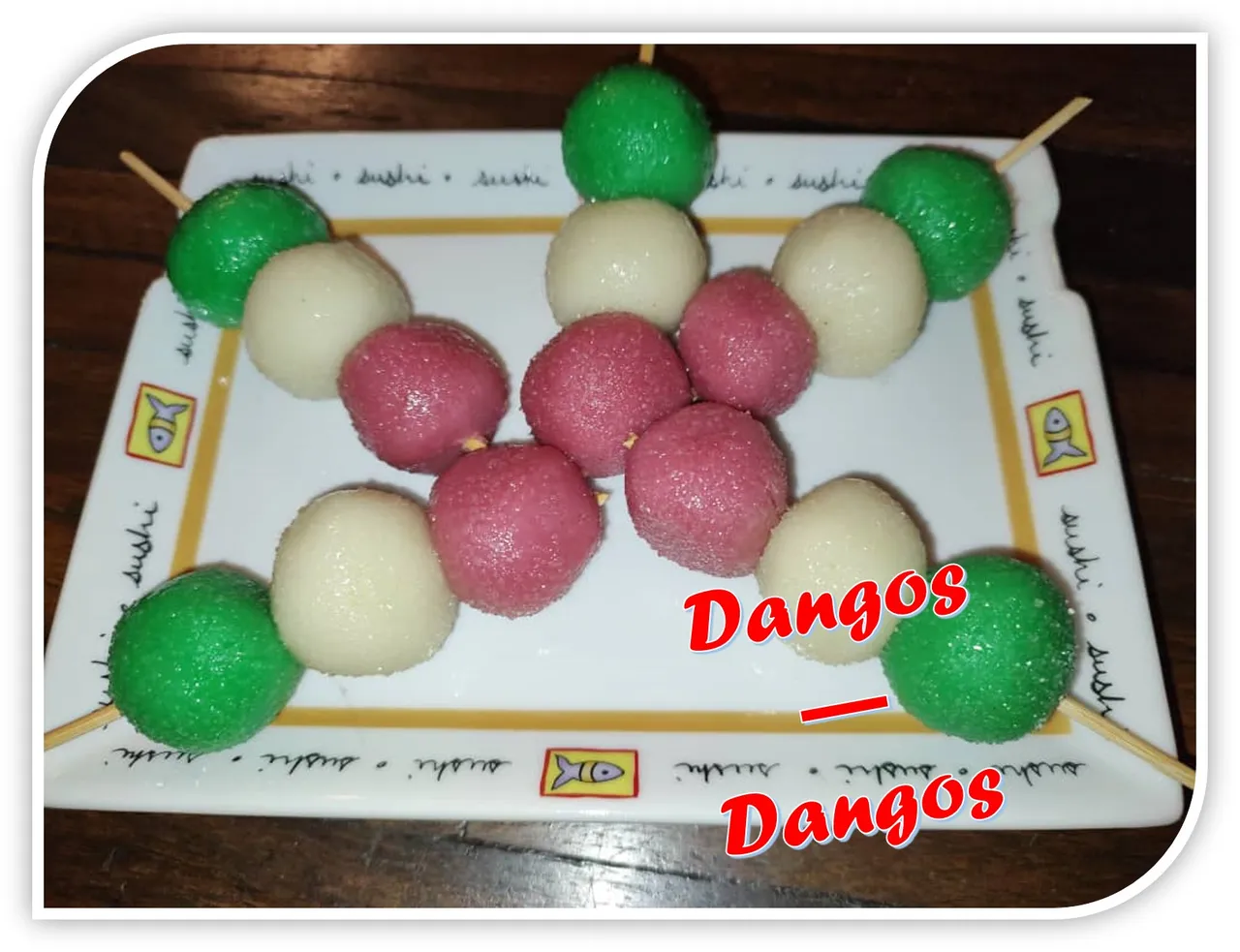

Ingredientes
Como dije antes, fue necesario sustituir algunos ingredientes debido a que no se encuentran en el mercado local, para empezar lo más importante es el arroz glutinoso o la harina del mismo, que fue reemplazado por crema de arroz, que es la presentación en la que se consigue la harina de arroz en mi país, y luego de eso también sustituimos los sabores, por los que verán a continuación.
Para unas 15 brochetas de dangos
- 300 gr de harina de arroz (crema de arroz)
- 3 cucharadas de azúcar
- Escénica de vainilla
- Saborizante de menta
- Té de frutos rojos
- Colorante alimentario rosa y verde
Ingredients
As I said before, it was necessary to substitute some ingredients because they are not found in the local market, to begin with the most important is the glutinous rice or rice flour, which was replaced by cream of rice, which is the presentation in which rice flour is obtained in my country, and after that we also substituted the flavors, for the ones you will see below.
For about 15 skewers of dangos
- 300 gr of rice flour (cream of rice)
- 3 tablespoons of sugar
- Vanilla flavor
- Mint flavoring
- Red fruit tea
- Pink and green food coloring

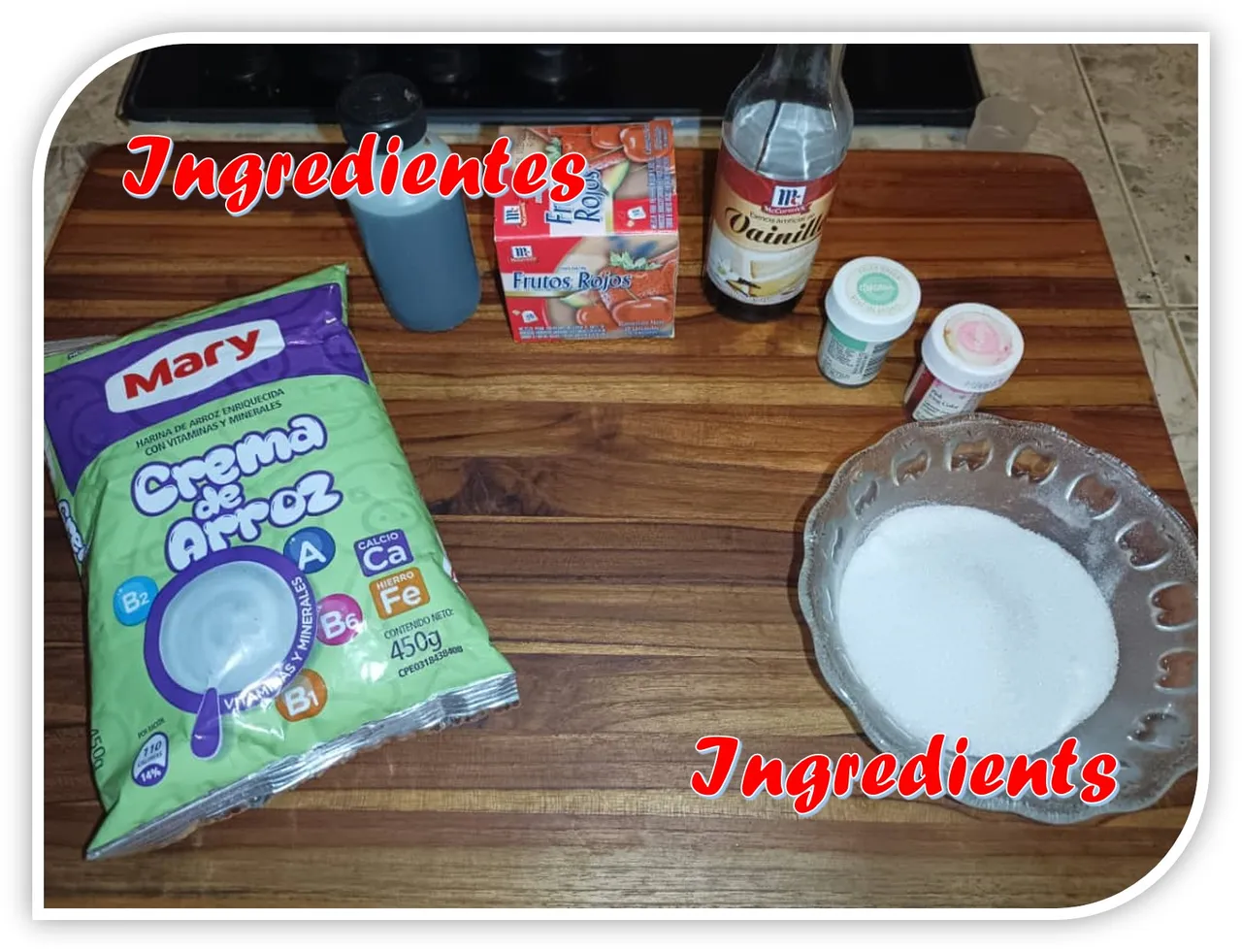

Procedimiento
Para empezar separaremos la harina de arroz en tres partes iguales y la dispondremos en bols separados (1), y le agregaremos una cucharada de azúcar a cada bol (2).
Empezaremos preparando los dangos de vainilla, que también serán los de color blanco, si bien pudimos dejarlos sin saborizante para que tuvieran su sabor original, preferimos hacerlo así, pues la crema de arroz ya viene ligeramente saborizada con vainilla, así que, solo reforzamos su sabor original.
Colocamos un chorrito de esencia de vainilla a la primera porción de harina y le agregamos, en partes, unos cien mililitros de agua caliente (hirviendo) (3), y mezclamos ayudándonos con un tenedor (4), iremos agregando poco a poco el agua hasta obtener una masa suave, pero que podamos manipular y dar forma con las manos (5), si la masa está muy seca o dura, se le puede agregar un poco más de agua, luego tomaremos porciones de masa y les daremos forma de bolita de unos 2 a 3 centímetros de diámetro (6), debería alcanzar como para unas 15 bolitas.
Procedure
To begin we will separate the rice flour in three equal parts and we will arrange them in separate bowls (1), and we will add a spoonful of sugar to each bowl (2).
We will begin by preparing the vanilla dangos, which will also be the white ones, although we could have left them without flavoring so that they have their original flavor, we prefer to do it this way, because the rice cream is already lightly flavored with vanilla, so we only reinforce its original flavor.
We put a dash of vanilla essence to the first portion of flour and add, in parts, about one hundred milliliters of hot (boiling) water (3), and mix with the help of a fork (4), we will add water little by little until we obtain a soft dough, but that we can manipulate and shape with our hands (5), if the dough is too dry or hard, you can add a little more water, then take portions of dough and shape them into balls of about 2 to 3 centimeters in diameter (6), it should be enough for about 15 balls.

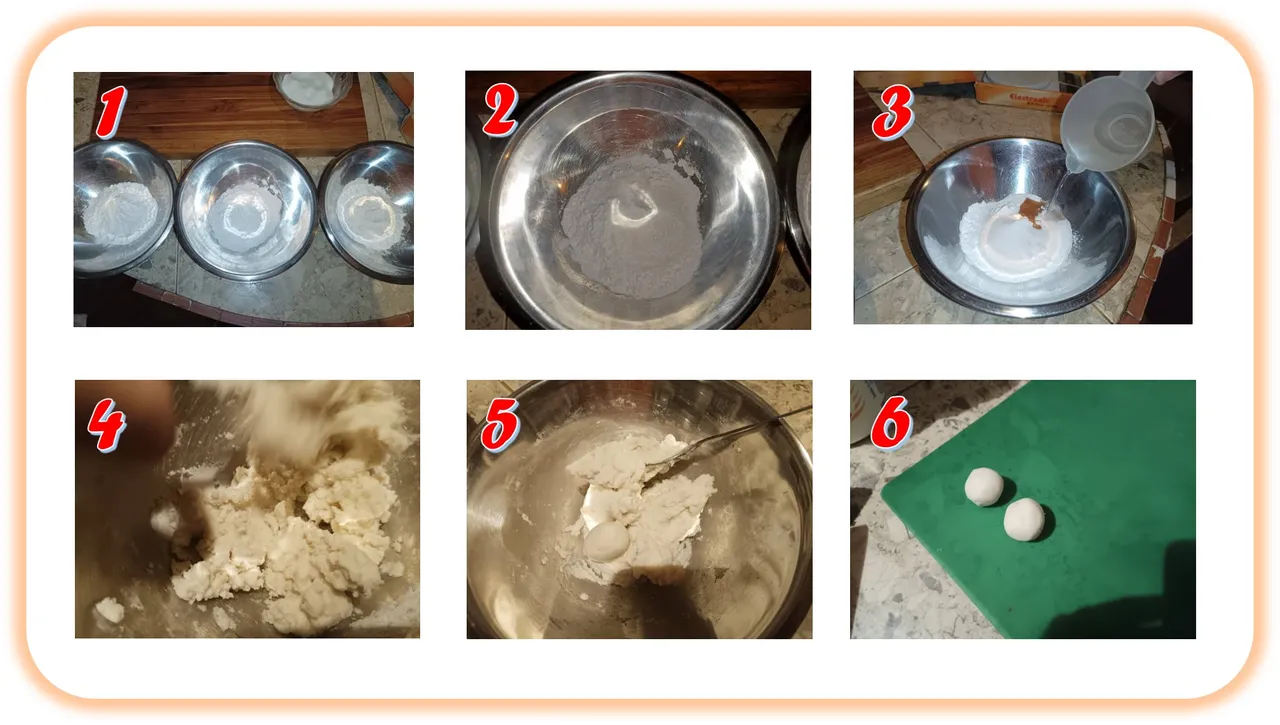

Para el siguiente tipo de dangos, prepararemos una taza de té de frutos rojos, dejando concentrar bien el té (7), y con él aún caliente verteremos, poco a poco, unos 100 ml de té al segundo bol de harina de arroz y azúcar (8), le colocaremos solo un poco de colorante rosa y procederemos a mezclar con un tenedor hasta obtener una masa suave, pero manipulable (9), y al igual que con la anterior mezcla, procederemos a formar bolitas con ella.
Finalmente, para el último sabor, diluiremos un chorrito de saborizante de menta (solo un poco) y una gota de colorante verde, en 100 ml de agua caliente (10) y procederemos a mezclarla con la harina restante (11), y al igual que los dos anteriores deberemos obtener una masa suave y manipulable (12), que porcionaremos y daremos forma de bolitas.
For the next type of dangos, we will prepare a cup of red fruit tea, letting the tea concentrate well (7), and with it still hot we will pour, little by little, about 100 ml of tea to the second bowl of rice flour and sugar (8), we will add just a little pink dye and proceed to mix with a fork until we obtain a soft but manageable dough (9), and as with the previous mixture, we will proceed to form balls with it.
Finally, for the last flavor, we will dilute a dash of mint flavoring (just a little) and a drop of green coloring, in 100 ml of hot water (10) and we will proceed to mix it with the remaining flour (11), and as with the two previous ones we will obtain a soft and manipulable dough (12), which we will portion and shape into balls.

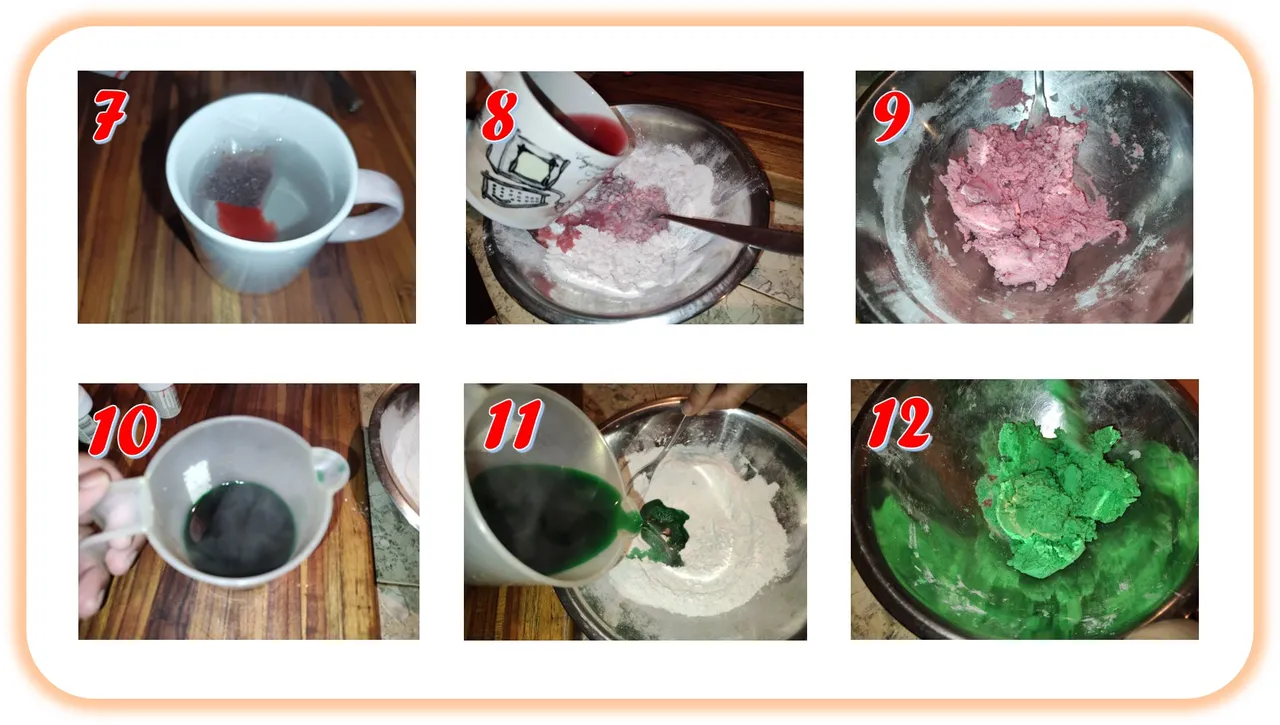

Ya con las bolitas formadas y separadas por color y sabor (13), procederemos a cocinarlas, lo cual haremos de forma separada para cada sabor, para así evitar que se mezclen los sabores o colores.
Cocinaremos los dangos en agua hirviendo (14), dejándolos hervir hasta que floten (15), en nuestro caso, nunca los vi flotar libremente en la superficie del agua, como pasa cuando preparamos ñoquis, pero si se puede notar que se mueven más suavemente en el fondo esto pasó como a los 10 minutos de hervor.
Cuando estén listos, los retiraremos del agua hirviendo y los pasaremos por un bol con agua fría con hielo, para cortar la cocción (16), los dejaremos un par de minutos para que se enfríen y luego los pasaremos por un pañito limpio o papel absorbente para secarlos (17) y los reservaremos.
Repetiremos este mismo procedimiento con los de cada color, cuidando de cambiar tanto el agua de cocción como la de enfriado en cada caso para prevenir que se mezclen los sabores o colores.
Once the dumplings are formed and separated by color and flavor (13), we will proceed to cook them, which we will do separately for each flavor, in order to avoid mixing flavors or colors.
We will cook the dangos in boiling water (14), letting them boil until they float (15), in our case, I never saw them float freely on the surface of the water, as it happens when we prepare gnocchi, but if you can notice that they move more smoothly on the bottom this happened about 10 minutes after boiling.
When they are ready, we will remove them from the boiling water and we will pass them through a bowl with cold water with ice, to cut the cooking (16), we will leave them for a couple of minutes to cool down and then we will pass them through a clean cloth or absorbent paper to dry them (17) and we will reserve them.
Repeat this same procedure with each color, taking care to change both the cooking and cooling water in each case to prevent the flavors or colors from mixing.

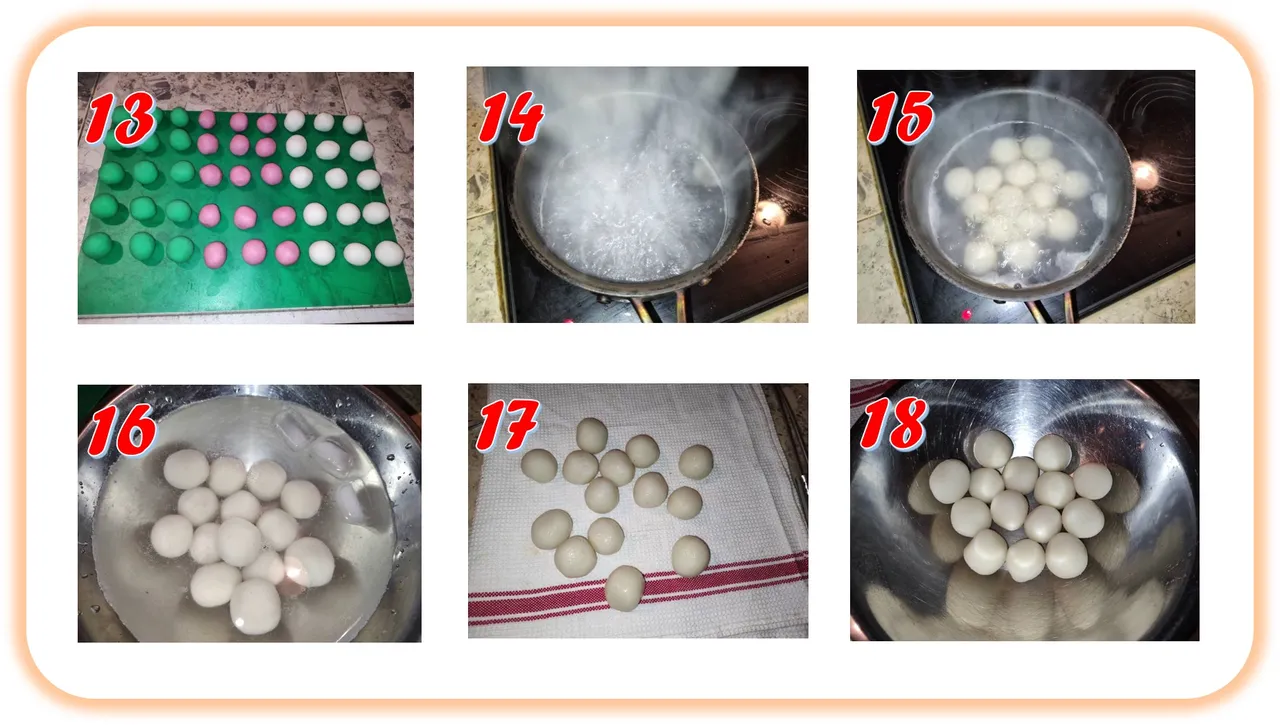

Con nuestros dangos ya cocinos y separados por color (19), procederemos a ensartarlos de a tres en palitos de brocheta, uno de cada color y según instrucciones de mi hija, debian ir en orden, verde, blanco y rosa, con el rosa en la punta del palito (20), como los preparamos para la hora del desayuno, se los presentamos con unas paquecas con pasas que son sus favoritas.
With our dangos already cooked and separated by color (19), we will proceed to thread them three by three on skewer sticks, one of each color and according to my daughter's instructions, they should go in order, green, white and pink, with the pink on the tip of the stick (20), as we prepare them for breakfast time, we present them with some pancakes with raisins that are her favorite.



Los dangos pueden servirse solos, o acompañados con una salsa dulce con base de salsa de soya, en nuestro caso sólo los espolvoreamos con un poco de azucar y los comimos tal cual, sin embargo no fueron lo que esperabamos, supongo que debido al cambio del tipo de harina, o tal vez los sobre cocine mucho, pero lo cierto es que no resultaron tan suaves y esponjosos como esperabamos, quedando más bien un poco duros de masticar y aunque los sabores quedaron bien, pudimos hacerlos un poco más dulces. Sin emabrgo pese a las complicaciones mi hija los disfrutó, espero que si los preparan puedan usar la harina correspondiente y obtengan un mejor resultado.
The dangos can be served alone, or accompanied with a sweet sauce based on soy sauce, in our case we just sprinkled them with a little sugar and ate them as they were, however they were not what we expected, I guess due to the change of the type of flour, or maybe I overcooked them too much, but the truth is that they were not as soft and fluffy as we expected, being rather a little hard to chew and although the flavors were fine, we could make them a little sweeter. However, despite the complications my daughter enjoyed them, I hope that if you prepare them you can use the corresponding flour and get a better result.

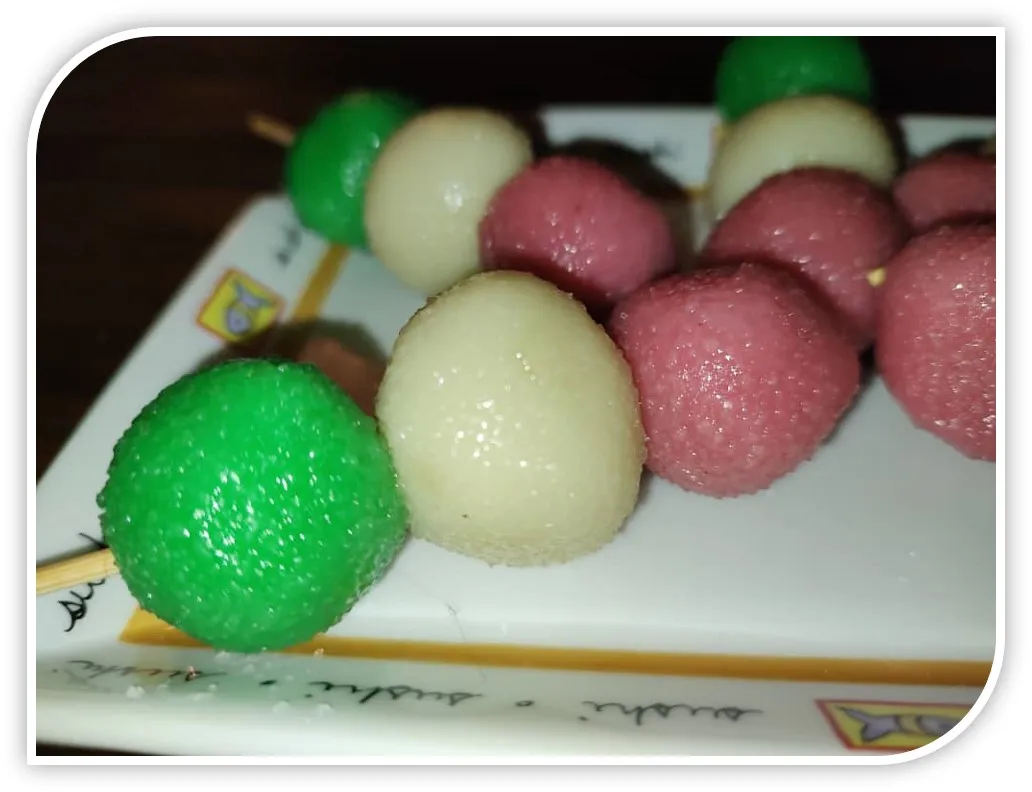

Todas las fotografías fueron tomadas con un movil Infinix Note 11 Pro